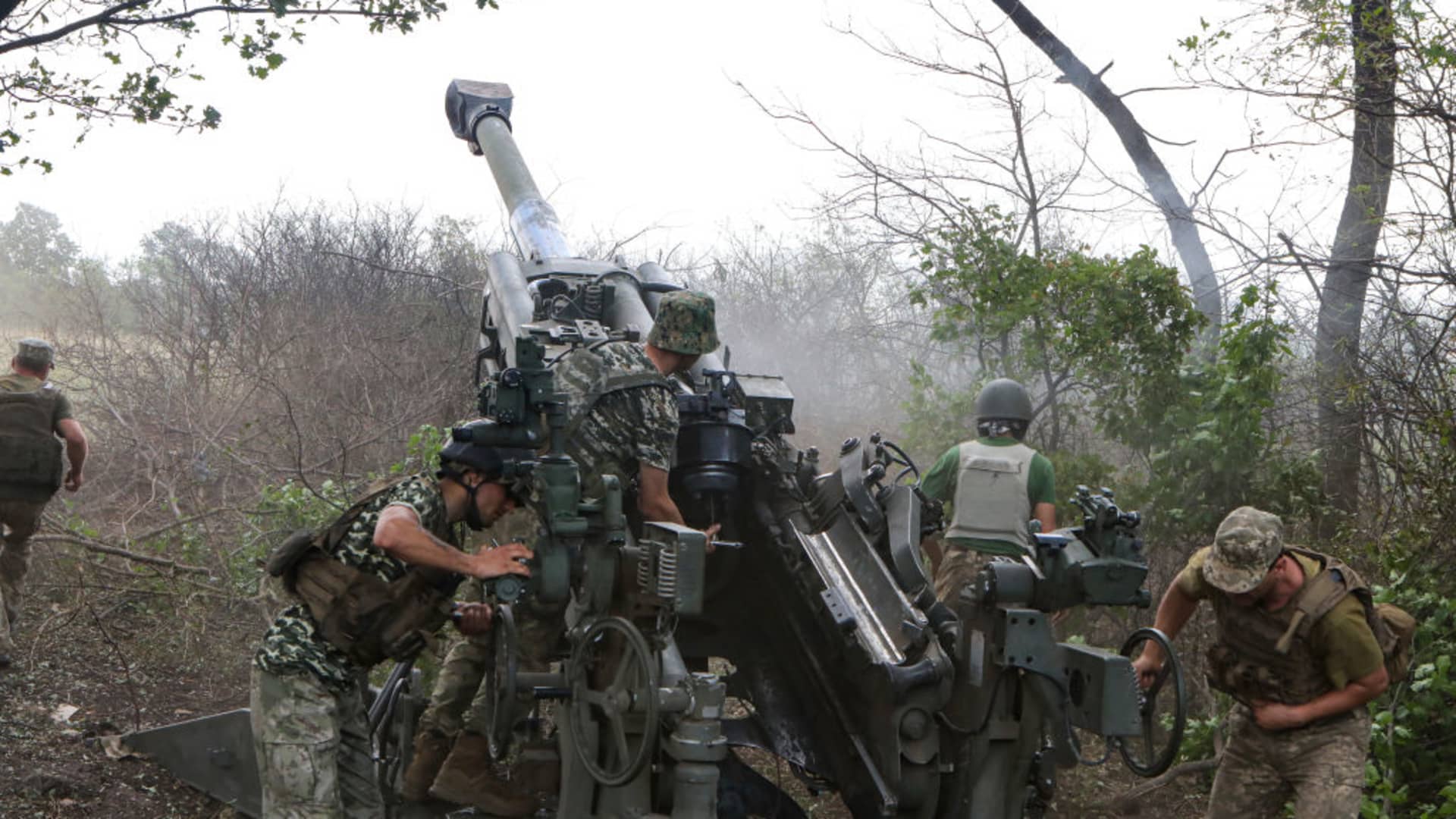
Ukrainian servicemen fire an M777 howitzer, Kharkiv Region, northeastern Ukraine. This photo cannot be distributed in the Russian Federation.
Vyacheslav Madiyevskyy | Future Publishing | Getty Images
In the U.S. weapons industry, the normal production level for artillery rounds for the 155 millimeter howitzer — a long-range heavy artillery weapon currently used on the battlefields of Ukraine — is about 30,000 rounds per year in peacetime.
The Ukrainian soldiers fighting invading Russian forces go through that amount in roughly two weeks.
That’s according to Dave Des Roches, an associate professor and senior military fellow at the U.S. National Defense University. And he’s worried.
“I’m greatly concerned. Unless we have new production, which takes months to ramp up, we’re not going to have the ability to supply the Ukrainians,” Des Roches told CNBC.
Europe is running low too. “The military stocks of most [European NATO] member states have been, I wouldn’t say exhausted, but depleted in a high proportion, because we have been providing a lot of capacity to the Ukrainians,” Josep Borrell, the EU’s high representative for foreign affairs and security policy, said earlier this month.
NATO Secretary-General Jens Stoltenberg held a special meeting of the alliance’s arms directors on Tuesday to discuss ways to refill member nations’ weapons stockpiles.
Military analysts point to a root issue: Western nations have been producing arms at much smaller volumes during peacetime, with governments opting to slim down very expensive manufacturing and only producing weapons as needed. Some of the weapons that are running low are no longer being produced, and highly-skilled labor and experience are required for their production — things that have been in short supply across the U.S. manufacturing sector for years.
A US M142 High Mobility Artillery Rocket System (HIMARS) firing salvoes during a military exercise on June 30, 2022. The U.S. Department of Defense has announced that the U.S. will be sending Ukraine another $270 million in security assistance, a package which will include high mobility artillery rocket systems and a significant number of tactical drones.
Fadel Senna | Afp | Getty Images
Indeed, Stoltenberg said during last week’s U.N. General Assembly that NATO members need to re-invest in their industrial bases in the arms sector.
“We are now working with industry to increase production of weapons and ammunition,” Stoltenberg told the New York Times, adding that countries needed to encourage arms makers to expand their capacity longer term by putting in more weapons orders.
But ramping up defense production is no quick or easy feat.
Is the U.S.’s ability to defend itself at risk?
The short answer: no.
The U.S. has been by far the largest supplier of military aid to Ukraine in its war with Russia, providing $15.2 billion in weapons packages to date since Moscow invaded its neighbor in late February. Several of the American-made weapons have been game changers for the Ukrainians; particularly the 155 mm howitzers and long-range heavy artillery like the Lockheed Martin-made HIMARS. And the Biden administration has said it will support its ally Ukraine for “as long as it takes” to defeat Russia.
That means a whole lot more weapons.
The U.S. has essentially run out of the 155 mm howitzers to give to Ukraine; to send any more, it would have to dip into its own stocks reserved for U.S. military units that use them for training and readiness. But that’s a no-go for the Pentagon, military analysts say, meaning the supplies reserved for U.S. operations are highly unlikely to be affected.
We need to put our defense industrial base on a wartime footing. And I don’t see any indication that we have.
Dave Des Roches
Senior military fellow, U.S. National Defense University
“There are a number of systems where I think the Department of Defense has reached the levels where it’s not willing to provide more of that particular system to Ukraine,” said Mark Cancian, a former U.S. Marine Corps Colonel and a senior advisor at the Center for Strategic and International Studies.
That’s because “the United States needs to maintain stockpiles to support war plans,” Cancian said. “For some munitions, the driving war plan would be a conflict with China over Taiwan or in the South China Sea; for others, particularly ground systems, the driving war plan would be North Korea or Europe.”
Javelins, HIMARs and howitzers
What this means for Ukrainian forces is that some of their most crucial battlefield equipment – like the 155 mm howitzer – is having to be replaced with older and less optimum weaponry like the 105 mm howitzer, which has a smaller payload and a shorter range.
“And that’s a problem for the Ukrainians,” Des Roches says, because “range is critical in this war. This is an artillery war.”
A boy walks past a graffiti on a wall depicting a Ukrainian serviceman making a shot with a US-made Javelin portable anti-tank missile system, in Kyiv, on July 29, 2022.
Sergei Supinsky | AFP | Getty Images
Other weapons Ukraine relies on that are now classified as “limited” in the U.S. inventory include HIMARS launchers, Javelin missiles, Stinger missiles, the M777 Howitzer and 155 mm ammunition.
The Javelin, produced by Raytheon and Lockheed Martin, has gained an iconic role in Ukraine — the shoulder-fired, precision-guided anti-tank missile has been indispensable in combating Russian tanks. But production in the U.S. is low at a rate of around 800 per year, and Washington has now sent some 8,500 to Ukraine, according to the CSIS — more than a decades’ worth of production.
Ukrainian soldiers take pictures of a mural titled ‘Saint Javelin’ dedicated to the British portable surface-to-air missile has been unveiled on the side of a Kyiv apartment block on May 25, 2022 in Kyiv, Ukraine. The artwork by illustrator and artist Chris Shaw is in reference to the Javelin missile donated to Ukrainian troops to battle against the Russian invasion.
Christopher Furlong | Getty Images
President Joe Biden visited a Javelin plant in Alabama in May, saying he would “make sure the United States and our allies can replenish our own stocks of weapons to replace what we’ve sent to Ukraine.” But, he added, “this fight is not going to be cheap.”
The Pentagon has ordered hundreds of millions of dollars’ worth of new Javelins, but ramping up takes time — the numerous suppliers that provide the chemicals and computer chips for each missile can’t all be sufficiently sped up. And hiring, vetting and training people to build the technology also takes time. It could take between one and four years for the U.S. to boost overall weapons production significantly, Cancian said.

“We need to put our defense industrial base on a wartime footing,” Des Roches said. “And I don’t see any indication that we have.”
A Lockheed Martin spokesman, when contacted for comment, referenced an April interview during which Lockheed CEO Jim Taiclet told CNBC: “We’ve got to get our supply chain ramped up, we’ve got to have some capacity, which we’re already investing to do. And then the deliveries happen, say, six, 12,18 months down the road.”
Raytheon and the U.S. Department of Defense did not respond to CNBC requests for comment.
What are Ukraine’s options?
In the meantime, Ukraine can look elsewhere for suppliers — for instance South Korea, which has a formidable weapons sector and in August inked a sale to Poland for $5.7 billion worth of tanks and howitzers. Ukrainian forces will also have to work with replacement weapons that are often less optimal.
A Ukrainian serviceman mans a position in a trench on the front line near Avdiivka, Donetsk region on June 18, 2022 amid the Russian invasion of Ukraine.
Anatolii Stepanov | AFP | Getty Images
Jack Watling, an expert on land warfare at the Royal United Services Institute in London, believes there is still ample scope for Ukraine to supply itself with many of the weapons it needs.
“There is sufficient time to resolve that problem before it becomes critical in terms of stepping up manufacture,” Watling said, noting that Kyiv can source certain ammunition from countries that don’t immediately need theirs, or whose stocks are about to expire.
“So we can continue to supply Ukraine,” Watling said, “but there is a point where especially with certain critical natures, the Ukrainians will need to be cautious about their rate of expenditure and where they prioritize those munitions, because there isn’t an infinite supply.”
